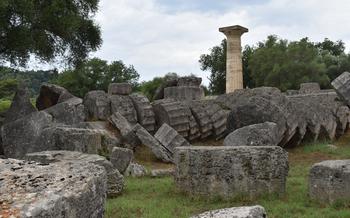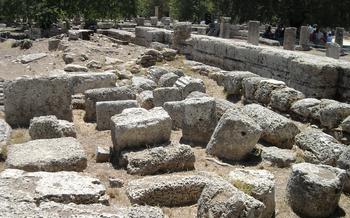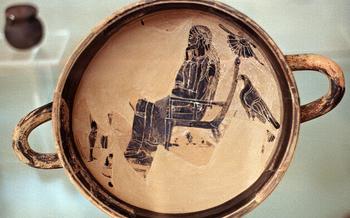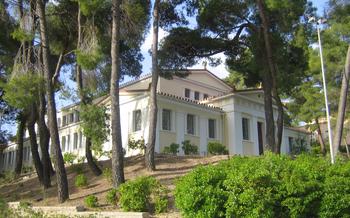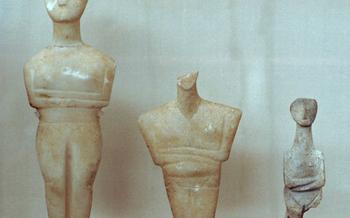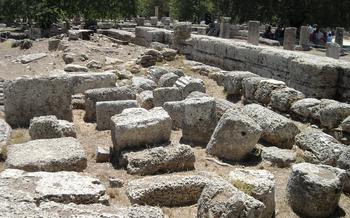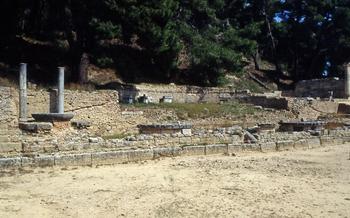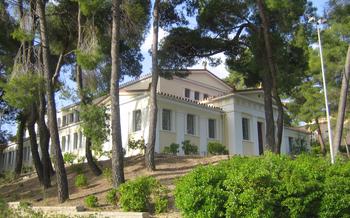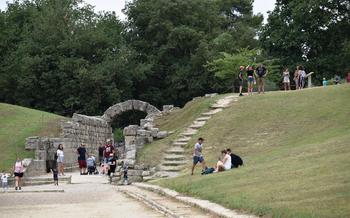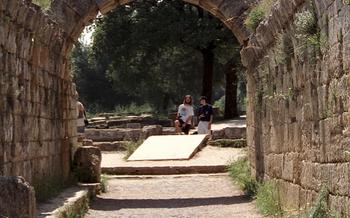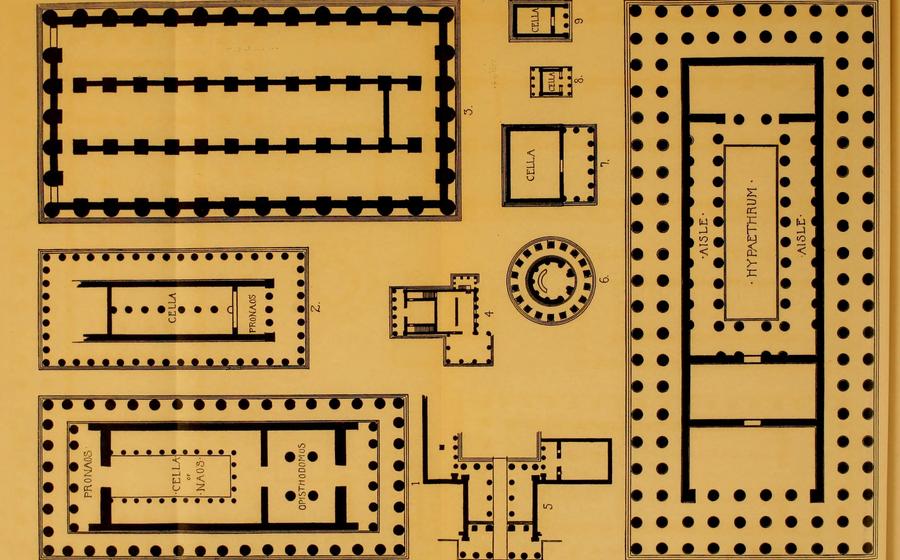
Ancient Olympia Theater
- Unveiling the Ancient Wonder: Olympia Theater
- A Journey Through Time: The History of Olympia Theater
- Architectural Masterpiece: Exploring the Theater's Design
- Echoes of Ancient Performances: The Theater's Acoustics
- Witnessing Ancient Dramas: The Theater's Performances
- The Festival of Zeus: A Grand Celebration
- Unveiling the Secrets: The Archaeological Museum of Olympia
- Following in the Footsteps of Ancient Athletes: The Stadium
- The Temple of Zeus: A Symbol of Power and Prestige
- Exploring the Peloponnese: Beyond Olympia
- Capturing the Essence: Photography Tips
- Unforgettable Souvenirs: What to Buy
- Savor the Flavors: Local Cuisine
- Insider Tip: Hidden Gems
Unveiling the Ancient Wonder: Olympia Theater
Nestled in the heart of the Peloponnese, the ancient city of Olympia holds a treasure trove of architectural wonders, historical significance, and cultural importance. Among its many marvels, the Olympia Theater stands as a testament to the ingenuity and artistry of ancient Greek civilization. Built in the 5th century BC, this magnificent theater served as a venue for religious ceremonies, musical performances, and theatrical productions, showcasing the vibrant cultural life of ancient Greece.
The Olympia Theater's legacy extends far beyond its original purpose. Today, it remains an iconic symbol of ancient Greek culture, attracting visitors from around the world who come to marvel at its architectural grandeur and immerse themselves in the spirit of antiquity. Whether you're a history buff, an architecture enthusiast, or simply someone who appreciates the beauty of ancient art, the Olympia Theater is a must-visit destination that will transport you back in time and leave you in awe of its enduring legacy.
A Journey Through Time: The History of Olympia Theater
The Olympia Theater, nestled in the sacred valley of Olympia, Greece, boasts a rich and captivating history that spans several centuries. Its origins can be traced back to the 5th century BC, when the theater was meticulously crafted to accommodate the growing number of spectators attending religious festivals and athletic competitions held in honor of Zeus, the king of the gods.
Initially constructed as a simple earthen embankment, the theater underwent significant transformations over time. During the 4th century BC, it was expanded and adorned with stone seats, transforming it into a magnificent spectacle. The theater's seating capacity eventually reached an impressive 5,000, catering to the increasing popularity of the Olympic Games and other cultural events.
Throughout its existence, the Olympia Theater served as a sacred space for religious ceremonies, particularly during the renowned Festival of Zeus. It was here that athletes, musicians, and performers gathered to showcase their talents and honor the gods. The theater's acoustics were meticulously engineered to ensure that the voices of actors and musicians could be heard clearly by every spectator.
As centuries passed, the Olympia Theater underwent several modifications and renovations. In the 2nd century AD, the stage was enlarged, and a monumental arched entrance was constructed. These enhancements reflected the growing importance of theatrical performances, which had become an integral part of the Olympic Games and other festivals.
Despite the passage of time and the ravages of nature, the Olympia Theater has endured as a testament to ancient Greek architecture and cultural achievements. In the 19th century, archaeological excavations unearthed the theater's ruins, revealing its grandeur and historical significance. Today, the theater stands as a beautifully preserved monument, inviting visitors to step back in time and experience the magic of ancient Greece.
Architectural Masterpiece: Exploring the Theater's Design
The Olympia Theater is a testament to the remarkable architectural prowess of the ancient Greeks. Its design combines functionality with aesthetics to create an awe-inspiring venue for performances. The theater is built on a hillside, taking advantage of the natural slope to create tiered seating arrangements. These seats rise up in a semicircular formation, providing excellent views of the stage and orchestra below.
The stage itself is an impressive sight, with a raised platform and a backdrop of elaborate columns and sculptures. The orchestra, located in front of the stage, is a circular area where the chorus performed and musicians played. The entire theater is meticulously crafted from local limestone, which has withstood the test of time and preserved the theater's grandeur to this day.
One of the most remarkable features of the theater is its acoustic perfection. The architects employed innovative techniques, such as the use of large jars buried beneath the seats, to amplify and enhance the sound. As a result, the actors' voices could be heard clearly by the entire audience, even in the farthest rows. This acoustic marvel continues to astound visitors, who can still experience the exceptional sound quality during performances held in the theater today.
Echoes of Ancient Performances: The Theater's Acoustics
The Olympia Theater's acoustics are a remarkable testament to the ingenuity and skill of ancient Greek architects. Through a combination of innovative design features and natural sound amplification, the theater ensured that every spectator could enjoy crystal-clear and resonant audio during performances.
The theater's unique horseshoe shape, with its steep tiers of seating rising in a semi-circle around the stage, played a crucial role in enhancing sound quality. This design allowed sound waves to bounce off the curved walls and reverberate throughout the space, creating an immersive acoustic experience.
The stage itself was constructed with a slightly raised platform and a curved back wall, resembling a giant acoustic shell. This design further amplified and directed sound toward the audience, ensuring that every word and note could be heard with remarkable clarity.
Adding to the theater's impressive acoustics, the surrounding hills and mountains acted as natural amplifiers, reflecting sound waves back into the theater and further enhancing the overall auditory experience.
In modern times, researchers and scientists have conducted extensive experiments to analyze and understand the theater's acoustics. These studies have confirmed the exceptional sound quality of the theater, demonstrating that even the faintest whispers spoken on stage could be heard clearly in the farthest rows of seats.
The Olympia Theater's acoustics stand as a testament to the advanced architectural knowledge and engineering prowess of the ancient Greeks. Their mastery of sound design has ensured that the theater continues to captivate audiences with its pristine acoustics, creating an immersive and unforgettable experience for visitors to this ancient wonder.
Witnessing Ancient Dramas: The Theater's Performances
The Olympia Theater was not just a venue for religious ceremonies but also a stage for various performances that showcased the artistic and cultural prowess of ancient Greece. Theatrical productions, music and dance recitals, and poetry readings brought the theater to life, entertaining and educating the audience.
-
Theatrical Productions: The theater's acoustics and stage design made it an ideal setting for theatrical performances. Ancient Greek dramas, comedies, and tragedies by renowned playwrights like Sophocles, Euripides, and Aristophanes were staged here. These plays explored themes of love, loss, heroism, and morality, captivating audiences with their intricate plots and powerful messages.
-
Music and Dance Recitals: The theater also hosted music and dance performances. Musicians played instruments like the lyre, flute, and drums, filling the air with melodies that complemented the dramatic performances. Dancers showcased their skills in rhythmic and graceful movements, adding visual appeal to the shows.
-
Poetry Readings: Poets recited their works to the gathered crowd, sharing their thoughts on philosophy, politics, and the human condition. The theater's acoustics allowed their words to resonate throughout the seating area, creating an intimate and immersive experience for the audience.
The Festival of Zeus: A Grand Celebration
In ancient Greece, the Festival of Zeus, also known as the Olympic Games, was a grand celebration that brought together athletes, spectators, and pilgrims from all corners of the Hellenic world. Held every four years in honor of Zeus, the king of the gods, the festival was a sacred and awe-inspiring event that showcased the pinnacle of athleticism, religious devotion, and cultural unity.
The origins of the festival can be traced back to the 8th century BC, when it was established as a local religious celebration in Elis. Over time, it evolved into a Panhellenic event, attracting participants and spectators from all over Greece and beyond. The games were held in a spirit of peace and truce, allowing even warring city-states to come together in harmony.
The festival's centerpiece was the athletic competitions, which included running, wrestling, boxing, chariot racing, and other sports. The victors were crowned with olive wreaths and hailed as heroes, their names forever etched in the annals of history.
Beyond the athletic contests, the festival also featured religious ceremonies and rituals. Pilgrims from across Greece flocked to Olympia to pay homage to Zeus and other deities, offering sacrifices and prayers at the temple dedicated to the king of gods.
The Olympic Games were not merely a sporting event; they were a profound expression of Greek culture and identity. They celebrated the human body, the pursuit of excellence, and the ideals of fair play and sportsmanship. The festival's legacy continues to this day, inspiring modern-day Olympic Games and serving as a reminder of the enduring power of sports to unite and uplift humanity.
Unveiling the Secrets: The Archaeological Museum of Olympia
Nestled in the heart of Olympia, the Archaeological Museum stands as a treasure trove of ancient artifacts, offering a glimpse into the rich history and culture of this sacred site. Established in 1886, the museum houses a vast collection of sculptures, statues, and other relics excavated from the ruins of Olympia, painting a vivid picture of the city's glorious past.
Among the museum's prized possessions is the iconic statue of Hermes carrying the infant Dionysus, a masterpiece by the renowned sculptor Praxiteles. This exquisite marble sculpture, dating back to the 4th century BC, captures the essence of divine grace and beauty, showcasing the artist's exceptional skill and attention to detail.
Another highlight of the museum is the collection of bronzes, including the famous Nike of Paeonius, a stunning winged victory statue that once adorned the Temple of Zeus. This remarkable piece, dating back to the 5th century BC, embodies the spirit of triumph and athletic prowess that defined the Olympic Games.
The museum also houses a wealth of artifacts related to the Olympic Games, including ancient discuses, javelins, and oil jars used by athletes. These relics provide a tangible connection to the ancient sporting traditions that originated in Olympia, shedding light on the significance of the games in Greek culture.
Interactive exhibits and multimedia displays enhance the museum experience, allowing visitors to delve deeper into the history of Olympia and its sacred rituals. Through these interactive elements, visitors can learn about the religious ceremonies, athletic competitions, and artistic performances that took place within the ancient city.
A visit to the Archaeological Museum of Olympia is an essential part of any journey to this sacred site. It offers a unique opportunity to explore the rich cultural heritage of Olympia and gain a deeper appreciation for the enduring legacy of the Olympic Games.
Following in the Footsteps of Ancient Athletes: The Stadium
Adjacent to the theater, the ancient stadium beckons visitors to step into the footsteps of legendary athletes. Built in the 5th century BC, this awe-inspiring structure hosted the iconic Olympic Games, where competitors from across Greece showcased their prowess in track and field events.
The stadium's elongated layout features a 600-meter-long track, flanked by gently sloping earthen embankments that served as seating for spectators. As you stand at the starting line, imagine the thrill and determination of ancient runners, preparing to unleash their speed and endurance.
The stadium's simplicity belies its significance. Here, the Olympic flame, a symbol of unity and sportsmanship, was kindled to mark the commencement of the games. This sacred flame continues to be lit in Olympia today, carried by torchbearers in a relay that culminates at the modern Olympic Games.
In the spirit of the ancient athletes, modern-day marathons retrace the footsteps of Pheidippides, the legendary messenger who ran from Marathon to Athens to deliver news of the Greek victory over the Persians. These races, often grueling yet exhilarating, pay homage to the enduring legacy of the Olympic Games.
The Temple of Zeus: A Symbol of Power and Prestige
Towering over the sacred precinct of Olympia, the Temple of Zeus stands as a testament to the grandeur and piety of ancient Greece. Constructed between 470 and 456 BC, this colossal Doric temple was dedicated to the king of the gods, Zeus, and symbolized the city's prominence as a religious and athletic center.
Its massive scale and intricate design were awe-inspiring. The temple measured approximately 64 meters in length, 27 meters in width, and 20 meters in height, with a peristyle of 34 fluted columns, each standing over 10 meters tall. The pediments, or triangular gables, were adorned with elaborate sculptures depicting the mythical battles between the Lapiths and the Centaurs, and the exploits of Hercules.
Inside the temple, a colossal statue of Zeus, crafted from ivory and gold by the renowned sculptor Phidias, resided. This masterpiece, standing over 12 meters high, was considered one of the Seven Wonders of the Ancient World and drew visitors from across the Hellenic world. The statue depicted Zeus seated on a magnificent throne, holding a scepter in one hand and a figure of Nike, the goddess of victory, in the other.
The Temple of Zeus was not only a place of worship but also a symbol of political power and prestige. Olympia was a sanctuary that attracted pilgrims and athletes from all over Greece, and the temple served as a focal point for religious ceremonies and festivals, including the renowned Olympic Games.
Tragically, the temple was destroyed by fire in the 5th century AD, and only its ruins remain today. Despite its ruined state, the Temple of Zeus continues to captivate visitors with its grandeur and historical significance, serving as a reminder of the enduring legacy of ancient Greece.
Exploring the Peloponnese: Beyond Olympia
While Olympia holds a wealth of ancient treasures, the Peloponnese region offers a diverse array of attractions beyond its borders. Ancient cities like Mycenae, Corinth, and Epidaurus beckon with their awe-inspiring ruins and historical significance. Natural wonders such as the stunning beaches of the Peloponnese coastline, the verdant valleys of Arcadia, and the towering mountains of the Taygetos range offer breathtaking landscapes and opportunities for outdoor adventures.
Venture off the beaten path to discover hidden gems like the medieval town of Monemvasia, perched on a rocky peninsula, or the picturesque village of Nafplio, with its Venetian fortress and charming harbor. Indulge in the region's culinary delights, savoring the fresh flavors of locally produced olive oil, honey, and wine.
Whether you're a history buff, a nature enthusiast, or a gastronome, the Peloponnese offers an abundance of experiences to enrich your journey. Embrace the region's rich tapestry of culture, history, and natural beauty as you explore beyond Olympia.
Capturing the Essence: Photography Tips
Olympia Theater, with its timeless beauty and architectural marvels, presents a remarkable opportunity for photography enthusiasts. To capture the essence of this ancient wonder, consider these expert tips:
-
Best Angles: Experiment with different perspectives to find the most captivating angles. Shoot from the front to capture the theater's majestic facade, or from the side to showcase its sweeping curves. For a unique vantage point, climb the surrounding hills for panoramic shots.
-
Lighting Conditions: The golden hours of sunrise and sunset cast a warm, ethereal glow on the theater, creating stunning photographic opportunities. Avoid harsh midday light, which can result in excessive shadows and washed-out colors.
-
Composition Techniques: Utilize the elements of composition to create visually appealing images. Frame the theater with natural elements like trees or columns to add depth and context. Incorporate leading lines, such as the rows of seats, to draw the viewer's eye into the scene.
-
Post-Processing Ideas: Enhance your photographs with post-processing techniques to bring out the best in your captures. Adjust the contrast and saturation to emphasize the theater's architectural details. Experiment with black-and-white conversions to create a timeless, monochromatic look.
Unforgettable Souvenirs: What to Buy
Olympia offers a treasure trove of unique souvenirs to commemorate your visit to this ancient land. From intricate local crafts to delectable culinary delights, there's something for every traveler.
-
Local Crafts: Discover handmade ceramics, woven textiles, and intricate jewelry crafted by local artisans. These beautiful pieces showcase the region's rich artistic traditions and make for meaningful mementos.
-
Olive Oil and Honey: Take home a bottle of the region's renowned olive oil, known for its rich flavor and health benefits. Pair it with a jar of aromatic honey, produced from the nectar of local wildflowers.
-
Ceramic Pottery: Olympia is home to a thriving community of potters who create stunning ceramic pieces using traditional techniques. Choose from a variety of vases, plates, and decorative items adorned with intricate designs.
-
Books and Souvenirs: Delve into the history and culture of Olympia with a selection of books and souvenirs. From guidebooks to historical novels, there's something for every enthusiast.
Savor the Flavors: Local Cuisine
Olympia offers a tantalizing culinary experience, showcasing the rich flavors of traditional Greek cuisine. Indulge in mouthwatering dishes crafted with fresh, local ingredients, reflecting the region's culinary heritage.
Start your day with a hearty breakfast of freshly baked bread, drizzled with golden olive oil and accompanied by sweet honey, a nod to the region's agricultural bounty. For a light and refreshing lunch, savor a crisp Greek salad, featuring ripe tomatoes, cucumbers, onions, and feta cheese, all tossed in a tangy vinaigrette.
Seafood lovers will delight in the array of freshly caught fish and seafood, grilled to perfection and seasoned with aromatic herbs. Sample the succulent shrimp, calamari, or octopus, each cooked with expertise and bursting with flavor.
No meal in Olympia is complete without a taste of the region's renowned olive oil, a staple ingredient that adds a distinct richness to every dish. Drizzle it over salads, grilled meats, or vegetables to enhance their natural flavors.
Pair your culinary journey with a glass of local wine, selecting from a range of varietals that showcase the region's diverse terroir. Sip on a crisp white wine with seafood dishes or savor a robust red wine with grilled meats.
For a sweet ending, indulge in traditional Greek desserts, such as baklava, a filo pastry filled with honey and nuts, or loukoumades, fluffy doughnuts served with honey syrup and cinnamon.
Whether you're dining at a traditional taverna or enjoying a picnic amidst the ancient ruins, Olympia's culinary delights will leave your taste buds tantalized and longing for more.
Insider Tip: Hidden Gems
Beyond the well-trodden paths of Olympia, a world of hidden treasures awaits the curious traveler. Venture off the beaten track to discover lesser-known sites that offer a glimpse into the region's rich history and culture. Unearth the ancient city of Elis, once a powerful rival to Olympia, and explore its fascinating ruins. For a unique perspective, embark on a hike up Mount Kronion, the sacred mountain that looms over the valley, and be rewarded with breathtaking views of the surrounding landscape.
Seek out the secluded beaches along the Ionian coast, where you can bask in the sun and swim in crystal-clear waters away from the crowds. Immerse yourself in the local culture by attending one of the many festivals and events that take place throughout the year, offering a chance to witness traditional music, dance, and cuisine.
Engage with the friendly locals, who are always eager to share stories and insights about their beloved region. They may lead you to hidden tavernas serving authentic Peloponnesian dishes, or guide you to secret viewpoints that offer unforgettable panoramas. Embrace the spirit of adventure and let your curiosity guide you as you explore the hidden gems of Olympia and its surroundings.
